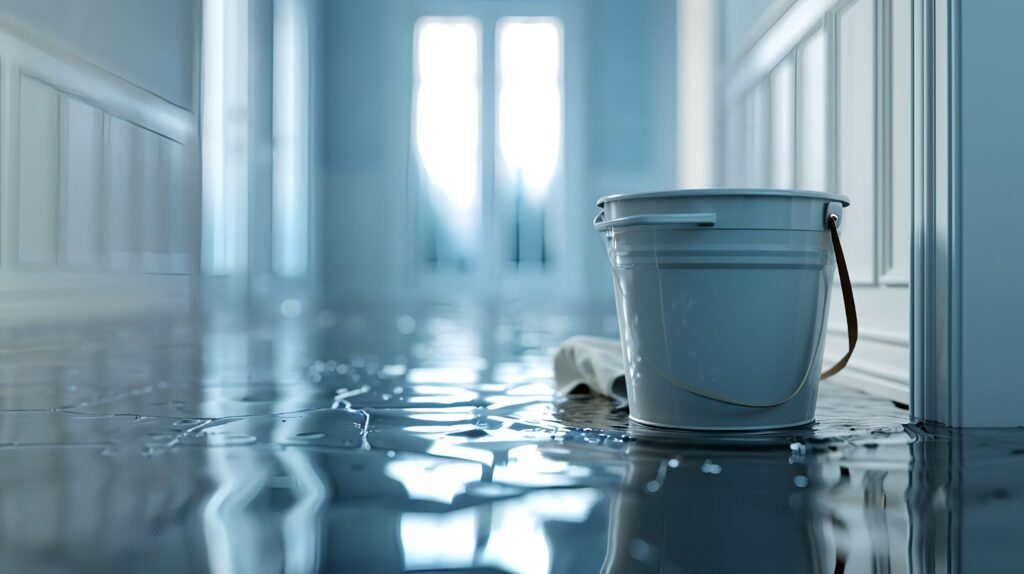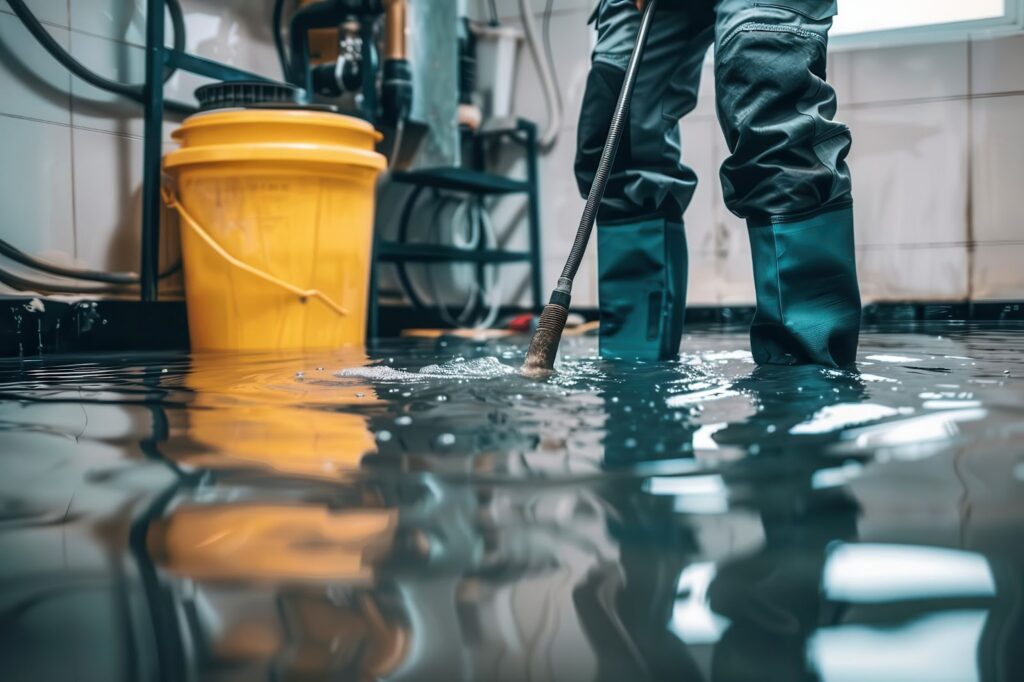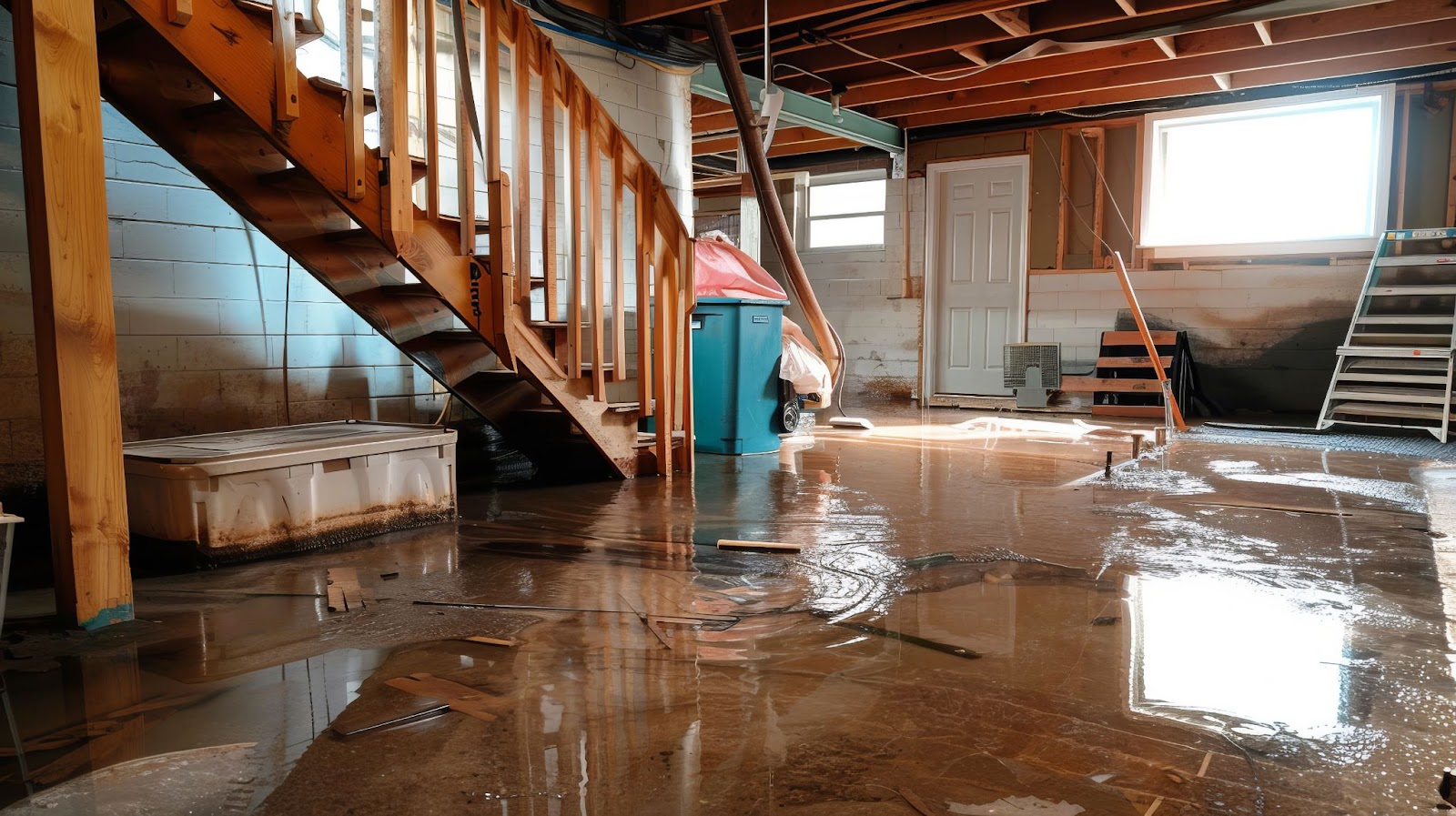Knowing how to get water out of your basement is crucial for preventing extensive damage and costly repairs.
Have you ever faced the daunting task of removing water from your basement? It’s a crucial consideration to address before it becomes a critical problem. Basement flooding is a homeowner’s worst nightmare, often requiring tons of time and effort to resolve.
Seeking help from a professional water damage restoration team is the best way to resolve this issue appropriately. Let’s explore some effective tips to help you get water out of your basement in a crisis.
Safety first
If you are wondering how to get water out of your basement, think safety first. Your initial reaction may be to rush into your basement to prevent more damage, but there are certain procedures to take ahead of time to ensure your safety. First, turn off all electricity to avoid electric shocks. If the water has risen above the electrical outlets, it’s safest to call an electrician before entering.
If you must enter the flooded region, wear safety gear such as rubber gloves and boots.
If you can’t safely access the power switch or the water damage is serious, call a flood repair specialist right away.
Assessment
Next, inspect the basement to determine the extent of the damage and identify any immediate dangers. The information collected here is critical for making an insurance claim and planning safe repairs. Here’s what you should be searching for:
- Mold and mildew – Look for evidence of mold development and be wary of musty scents. Mold grows fast, so be vigilant, even if it is not immediately obvious.
- Hidden water – Look for any indicators of concealed water damage, such as wet stains, warped surfaces, or leaking noises. Damage is often hidden behind walls or beneath floors.
- Structural issues – Inspect the walls, floors, and ceilings thoroughly. Look for cracks, shifting, bulging, or other alterations that didn’t previously exist. If you notice any severe structural issues, contact a structural engineer or certified contractor right away to conduct a safety evaluation.
- Appliances – Have a trained electrician or technician evaluate any flood-damaged appliances or utility systems, such as your washing machine or water heater.
- Document everything – As you move through the basement, take thorough images and videos of the whole area as well as specific damages. Take inventory of all damaged items, including descriptions, brand names, model numbers, approximate ages, and replacement costs. If the water damage was caused by a covered occurrence, you’ll need to present this documentation to support your insurance claim.
Once you have completed your assessment, it’s time to start the water removal and drying process. Keep in mind that not all basements are the same — some have concrete floors, others are carpeted, and some even feature wood flooring. Each floor type has different steps for damage restoration. Let’s explore each type and the proper steps on how to get water out of your basement.
How to dry carpet floors
Basement flooding can leave your carpets moist and spongy, which is a big concern when it comes to damage restoration. Besides the stench, it will also lead to mold and mildew if not taken care of quickly and properly.

Remove the water source
Be it a plumbing issue, a foundation leak, or excessive rain, addressing the root cause is vital. Fix any minor leaks or spills promptly. For more serious flooding, you might need professional help to stop the water source and prevent even more damage.
Remove excess water
Next, remove as much water as possible — a wet vacuum works great for this. Just switch it to ‘wet’ mode and use it carefully on the carpet. Move it slowly to let it suck up as much water as possible.
Lift the carpet
Carefully lift the edges of the carpet off the floor — be gentle to avoid damaging the carpet or the carpet pad. This step is crucial to let air circulate underneath and speed up drying. Use bricks, wooden blocks, or other non-staining materials to prop up the carpet.
Increase airflow
Next, gather as many fans as you have on hand. Position them in the basement to point at the damp carpet. This increases evaporation and accelerates the drying process significantly. In addition to floor fans, you can use box, oscillating, or ceiling fans if available. Opening basement windows and using a dehumidifier will also help minimize moisture.
Clean
Moisture often leads to unpleasant smells. If you’re experiencing this, baking soda is a great natural deodorizer. Just sprinkle it generously over the wet basement carpet. After a few hours, dry vacuum the carpet to get rid of the excess baking soda. For stubborn odors or stains, try commercial carpet cleaners.
Call a professional
Restoration pros can access specialized gear like powerful carpet dryers and dehumidifiers to ensure thorough drying and prevent mold growth. They’re skilled at handling more serious water damage issues, too. They’ll assess your carpet’s condition and recommend the best action plan. If there’s been severe flooding, they will help prevent further structural problems or health risks associated with mold and mildew.
How to dry concrete floors
Many basements have concrete floors. If the flooding isn’t too severe, you might think the floor will dry out on its own after you remove the excess water. However, if the concrete isn’t thoroughly dried, it can crack or fail to bond with the water-based adhesives used in carpeting. Here’s a quick guide on how to dry a basement with concrete floors:
Remove Water
Use a wet vacuum or pool pump, if available, to remove water efficiently. If these tools aren’t accessible, a bucket and mop will get the job done. For severe flooding, consider renting a sump pump to speed up the water removal procedure. Don’t forget to inspect any concealed areas where water might build, such as behind appliances and under the stairs.
Get the air flowing
Next, open the windows to let air circulate in your basement. Install fans around the space, directing airflow to moist areas, walls, and corners. Standard box fans will suffice, but renting or purchasing high-powered commercial fans will substantially accelerate the process
How to dry wood floors
It is critical to promptly dry wood floors after a flood, just as you would with carpet or concrete. Wood discolors and deforms when damp, so act quickly.
Move furniture
Leaving furniture or heavy appliances on a damp wood floor can cause further damage, so move them out of the way for drying.
Water removal
A wet-dry vacuum is your best option for getting as much water out of your wood floors as possible. If the flooding is extensive, calling in a water damage restoration company is essential.
Clean the floor
Hardwood flooring is vulnerable to mold if it becomes too wet, so wipe the floor with a wood floor-friendly disinfectant once any standing water has been removed.
Dehumidifier
To begin the water damage restoration process, place a dehumidifier or powerful fan in the center of your basement. Turn on the air conditioning in your basement to further assist with drying. Your basement floor might take up to six weeks to completely dry, so exercise patience before sanding or refinishing it.

Basement flooding prevention
We’ve covered several methods for getting water out of your basement. Now, let’s explore some tips to prevent water from entering in the first place. Prevention is always the best strategy.
- Gutters – Keeping your gutters clean is an easy way to prevent flooding. Leaves, twigs, and debris can block them, causing water to pool against your foundation. Install downspout extensions to direct rainfall away from the foundation.
- Humidity – Condensation on basement walls and other surfaces indicates the presence of humidity. Check for condensation and call in the pros if you notice it increasing.
- Unsealed concrete – Unsealed concrete flooring commonly found in basements is porous and collects moisture. Mold develops when moisture does not dry completely. Sealing your concrete flooring creates a healthy moisture barrier.
- Mildew – Moisture from cracks or gaps in walls, shifting foundations, broken floor drains, leaking appliances, and other sources leads to the growth of mildew and smells. Spray a moderate bleach solution (one cup of bleach mixed with one gallon of water) in the basement regularly to keep mildew and musty odors at bay.
Contact Black Diamond Restoration today!
How to get water out of your basement is difficult, time-consuming, and requires expert knowledge and equipment to ensure complete restoration — this is where Black Diamond Restoration comes in.
Instead of risking more damage to your property and health, let the professionals at Black Diamond Restoration perform the task safely and effectively.
From water damage caused by broken appliances to burst pipes and storm-related difficulties, our Water Damage professionals have seen it all. Trust us to analyze, repair, and return your property to a pre-loss state quickly and effectively. Contact Black Diamond Restoration today!







